Newsreels
Liberation News, newsreels that were discovered in Osaka and restored by the Korean Film Archive in conjunction with the sixtieth anniversary of liberation, will be shown. Also screened will be Choren News and Chongryon Review, both of which contain many rare and valuable images, as well as Asahi News, which addressed the repatriation issue from the 1950s through the 1960s.
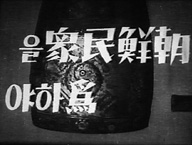 Liberation News
Liberation News
(“Kaiho nyusu”)- KOREA / 1946 / Korean / B&W / 35mm / 30 min total
Source: Planet Bibliothèque de Cinéma
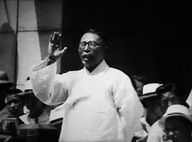 Planet Bibliothèque de Cinéma acquired these four newsreels more than ten years ago, and they were finally restored by the Korean Film Archive (KOFA) at the end of last year. This year, the 60th anniversary of liberation, they were shown at Real Fantastic Film Festival (Seoul). According to KOFA, they are not part of the well-known Liberation News by the Chosen Film Construction Headquarters, which was made up of liberal filmmakers, but newsreels which had never before appeared in the records of Korean film history. Because the label on the film can reads, “Fuse [town], Osaka,” it is believed that they were shown to zainichi Koreans at the time.
Planet Bibliothèque de Cinéma acquired these four newsreels more than ten years ago, and they were finally restored by the Korean Film Archive (KOFA) at the end of last year. This year, the 60th anniversary of liberation, they were shown at Real Fantastic Film Festival (Seoul). According to KOFA, they are not part of the well-known Liberation News by the Chosen Film Construction Headquarters, which was made up of liberal filmmakers, but newsreels which had never before appeared in the records of Korean film history. Because the label on the film can reads, “Fuse [town], Osaka,” it is believed that they were shown to zainichi Koreans at the time.
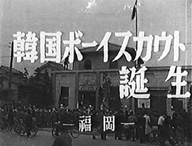 Japanese Newsreels
Japanese Newsreels
- JAPAN / 1951–68 / Japanese / B&W / Video (Original: 35mm) / 30 min total
Production Company, Source: Nippon Eiga Shinsha
Until the spread of television, news was shown primarily in movie theaters. In addition to Nihon News, Bunka News, Asahi News, Mainichi World News, Nikkatsu World News, Yomiuri International News, Chunichi News, Toei News, and Movie Times, there were multiple foreign-owned newsreels. Here is a collection of zainichi-related stories from Nihon News and Asahi News. One is struck by the overwhelming attention given to the repatriation effort, which was a political issue at the time.
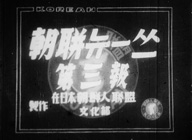 Choren News
Choren News
(“Choren nyusu”)- JAPAN / 1945–47 / Korean / B&W / 16mm, 35mm (Original: 35mm) / 60 min total
Production Companies: League of Koreans in Japan Cultural Affairs, Department (No. 2, No. 3), Minshu Eiga (No. 7, No. 8, No. 10, No. 13)
Source: Chongryon Film Studio
These newsreels were produced both by the cultural affairs department of the League of Koreans in Japan (Choren), which commenced activities in Japan post-liberation, and by the subsequently inaugurated Minshu Eiga Incorporated. Produced with the intention of being shown on the Korean Peninsula as well as in Japan, they contain a record of five members of Choren, including Kim Jeong-hong, being dispatched to the peninsula in 1946; of their meeting in Seoul on May 7 when they created an association to report on zainichi Korean affairs; and of the screening of Choren News. The installments to be shown at YIDFF are No. 2 and No. 3, produced by the cultural affairs department of the League of Koreans in Japan, and No. 7, No. 8, No. 10, and No. 13, produced by Minshu Eiga. Since the sound negatives are no longer extant, we regret that the newsreels will be shown without sound.
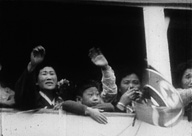 Chongryon Review
Chongryon Review
(“Soren jiho”)- JAPAN / 1959–69 / Korean / B&W / 16mm / 70 min total
Production: Alliance of Korean Writers and Artists in Japan
Source: Chongryon Film Studio
These newsreels were initially produced in 1959 by the film department of the Alliance of Korean Writers and Artists in Japan (Bungeido). Production shifted to the current Chongryon Film Studio following its establishment in 1972, with footage from the total of 124 installments issued reflecting the lives of zainichi Koreans at the time. Six installments—No. 4, No. 7, No. 20, No. 39, No. 45 and No. 65—will be shown. The opening installment No. 4 is First Repatriation Ship, which depicts the return of zainichi Koreans to the homeland based on a repatriation agreement reached between the North Korean and Japanese Red Cross Societies in August 1959.
